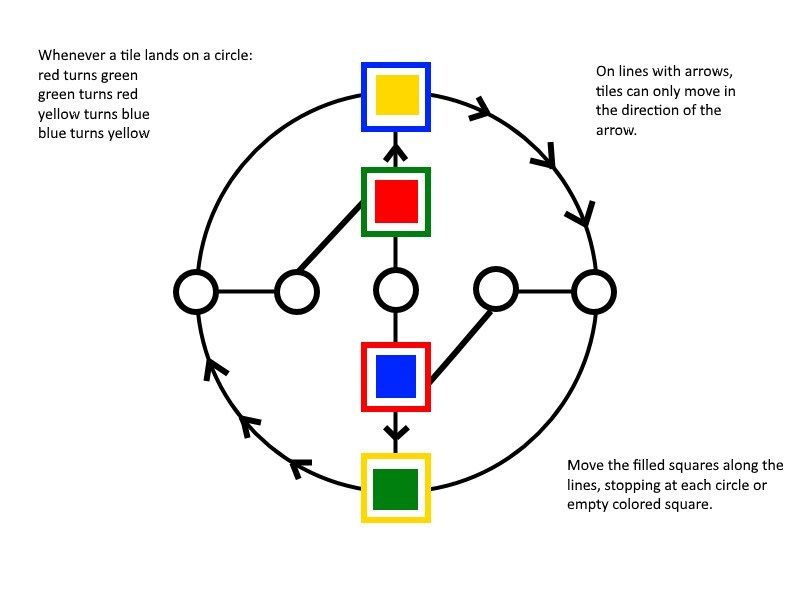Hi all, posted this over on the Dungeon Master's Block forums a little while ago, but thought I'd repost here.
I wanted to share a puzzle concept you can bring to your table. I've used these in my world as the locks to "bonus treasures" in a themed area. In my games, they appear as gems embedded in a wall with grooves, but the idea can be converted into whatever suits your setting. Once you know the principles of operating them, you can design an infinite number of puzzles. Whether or not puzzles are fun for your table is another conversation entirely, of course!
I won't claim to be the first person to come up with this puzzle idea; some variation on it probably already exists out there, at least in a video game if nowhere else. Nevertheless, the conception came to me without outside sources, so you'll have to forgive me if I can't give credit.
You'll need multicolored tiles or tokens, a drawing surface, and a pen. I use 1-inch plastic square tiles, wet erase markers, and my vinyl battle mat. If nothing else, you can use colored paper cutouts, or white paper and markers.
Draw a number of circles and squares, and connect them with lines. Geometric patterns create a cooler visual than complete randomness IMO (see below), but the exact appearance is arbitrary. Circles should be neutral (black), while squares are color coded. You'll use at least as many colored tiles as you have squares. The colored tiles can move along the lines. On lines marked with arrows, tiles can only move in that direction. At junctions marked by a circle, the tile changes color. Once all the colored squares are filled with the matching colored tile, the puzzle is solved.
For simple puzzles, use fewer circles, fewer colors, and make the color change binary (red turns to blue, blue turns to red; green turns to yellow, yellow turns to green). For more complex puzzles, add additional colors, circle junctions, one-way lines, and rotate the color change through more colors.
To further increase the challenge, require completion of the puzzle in a certain number of moves. You can also add consequences for placing the wrong color tile in a square (ex: red tile in blue square causes fire damage).
I've dreamt up a few more variations on this general idea, but will leave it at that for now.
Here is an illustrated examples of a puzzle. A final note, make sure you can solve your own damn puzzle before you force it on your players!
(Also, give me a heads up if the rules aren't clear enough, or if you'd like additional guidance on constructing your own)

I wanted to share a puzzle concept you can bring to your table. I've used these in my world as the locks to "bonus treasures" in a themed area. In my games, they appear as gems embedded in a wall with grooves, but the idea can be converted into whatever suits your setting. Once you know the principles of operating them, you can design an infinite number of puzzles. Whether or not puzzles are fun for your table is another conversation entirely, of course!
I won't claim to be the first person to come up with this puzzle idea; some variation on it probably already exists out there, at least in a video game if nowhere else. Nevertheless, the conception came to me without outside sources, so you'll have to forgive me if I can't give credit.
You'll need multicolored tiles or tokens, a drawing surface, and a pen. I use 1-inch plastic square tiles, wet erase markers, and my vinyl battle mat. If nothing else, you can use colored paper cutouts, or white paper and markers.
Draw a number of circles and squares, and connect them with lines. Geometric patterns create a cooler visual than complete randomness IMO (see below), but the exact appearance is arbitrary. Circles should be neutral (black), while squares are color coded. You'll use at least as many colored tiles as you have squares. The colored tiles can move along the lines. On lines marked with arrows, tiles can only move in that direction. At junctions marked by a circle, the tile changes color. Once all the colored squares are filled with the matching colored tile, the puzzle is solved.
For simple puzzles, use fewer circles, fewer colors, and make the color change binary (red turns to blue, blue turns to red; green turns to yellow, yellow turns to green). For more complex puzzles, add additional colors, circle junctions, one-way lines, and rotate the color change through more colors.
To further increase the challenge, require completion of the puzzle in a certain number of moves. You can also add consequences for placing the wrong color tile in a square (ex: red tile in blue square causes fire damage).
I've dreamt up a few more variations on this general idea, but will leave it at that for now.
Here is an illustrated examples of a puzzle. A final note, make sure you can solve your own damn puzzle before you force it on your players!
(Also, give me a heads up if the rules aren't clear enough, or if you'd like additional guidance on constructing your own)

Last edited:
